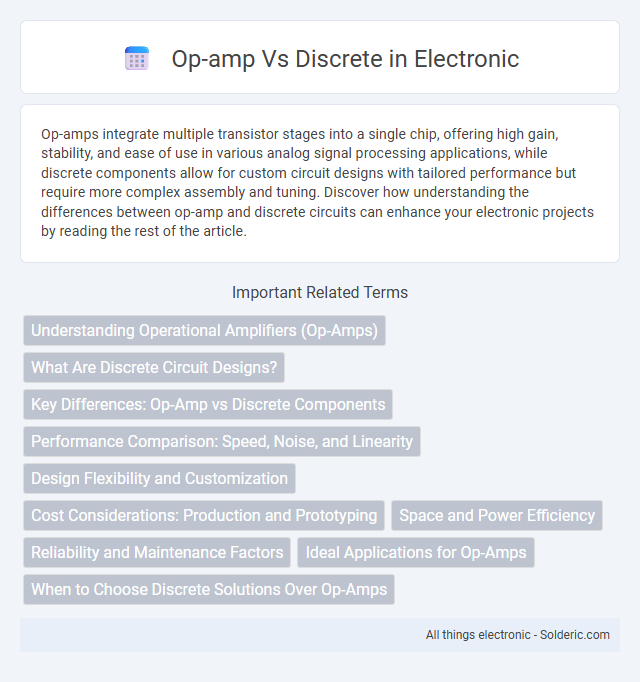Op-amps integrate multiple transistor stages into a single chip, offering high gain, stability, and ease of use in various analog signal processing applications, while discrete components allow for custom circuit designs with tailored performance but require more complex assembly and tuning. Discover how understanding the differences between op-amp and discrete circuits can enhance your electronic projects by reading the rest of the article.
Comparison Table
| Feature | Op-Amp (Operational Amplifier) | Discrete Components |
|---|---|---|
| Definition | Integrated circuit with multiple transistors, resistors, and capacitors. | Individual semiconductor devices like transistors, resistors, and capacitors used separately. |
| Size | Compact, small form factor. | Larger, due to separate components. |
| Performance | Consistent, high gain, low offset voltage. | Variable performance based on component matching and assembly. |
| Complexity | Simplifies circuit design with integrated functionality. | Requires intricate design and assembly for similar functions. |
| Cost | Generally lower in mass production. | Higher due to multiple individual parts. |
| Customization | Limited to available chip designs. | Highly customizable at component level. |
| Applications | Amplification, filtering, analog signal processing in compact devices. | Custom circuits, high-frequency designs, or specialized analog functions. |
Understanding Operational Amplifiers (Op-Amps)
Operational amplifiers (op-amps) are integrated circuits designed to perform a wide range of analog signal processing tasks with high gain and precision, offering advantages in size, consistency, and ease of use compared to discrete transistor configurations. Discrete designs, built from individual transistors, provide greater flexibility and customization but often require more complex calibration and have larger footprints. Understanding the fundamental differences in noise performance, bandwidth, and linearity between op-amps and discrete amplifiers helps you choose the optimal solution for analog circuit design.
What Are Discrete Circuit Designs?
Discrete circuit designs utilize individual components such as transistors, resistors, capacitors, and diodes to build electronic circuits, offering precise control over each element in the signal path. Unlike op-amps, which integrate multiple functions into a single package, discrete circuits allow tailored performance characteristics like custom gain, bandwidth, and noise levels. These designs are often preferred in high-fidelity audio applications and specialized analog circuits where component-level optimization is critical for achieving superior sound quality or specific electrical behavior.
Key Differences: Op-Amp vs Discrete Components
Op-amps integrate multiple transistor stages into a single compact package, offering high gain, stability, and ease of use compared to discrete components, which are individual transistors, resistors, and capacitors assembled separately. Discrete components provide greater customization and control over circuit parameters but require more design complexity and space. Op-amps excel in applications needing consistent performance and simplified design, while discrete components are preferred for tailored, high-frequency, or high-power circuits where precise tuning is essential.
Performance Comparison: Speed, Noise, and Linearity
Op-amps generally offer higher speed and better linearity due to integrated design and advanced fabrication techniques, resulting in faster slew rates and lower distortion compared to discrete transistor circuits. Discrete designs can sometimes achieve lower noise floors by using carefully selected, low-noise components and custom biasing, but they often struggle to match the consistent performance of precision op-amps. Overall, integrated op-amps provide superior speed, noise performance, and linearity for most applications, while discrete circuits are preferred for specialized, low-noise, or high-voltage scenarios.
Design Flexibility and Customization
Op-amps offer limited design flexibility due to their fixed internal architecture, making customization challenging for specific performance requirements. Discrete components allow greater customization, enabling precise tuning of parameters like gain, bandwidth, and noise through individual selection and configuration of transistors, resistors, and capacitors. Your design benefits from discrete circuits when unique or optimized performance characteristics are critical for specialized applications.
Cost Considerations: Production and Prototyping
Operational amplifiers (op-amps) offer significant cost advantages in production due to their integrated design, reducing component count and assembly time compared to discrete amplifier circuits that require multiple individual transistors, resistors, and capacitors. Prototyping with op-amps accelerates development by providing standardized, off-the-shelf solutions with predictable performance and lower design complexity, whereas discrete designs involve higher labor costs and longer iteration cycles to optimize component matching and circuit stability. In large-scale manufacturing, the unit cost of op-amps typically decreases significantly due to economies of scale, making them a more economical choice than discrete alternatives for both analog and mixed-signal applications.
Space and Power Efficiency
Op-amps offer superior space efficiency by integrating multiple components into a single chip, significantly reducing PCB footprint compared to discrete transistor setups. Power efficiency in op-amps is optimized through specialized fabrication processes that minimize quiescent current, whereas discrete designs often consume more power due to individual device biases. Your choice between op-amps and discrete circuits depends on the balance of space constraints and power consumption requirements in your application.
Reliability and Maintenance Factors
Op-amps offer higher reliability due to their integrated design, minimizing the risk of component failure and simplifying maintenance tasks. Discrete circuits, composed of individual components, can be more prone to wear and environmental damage, requiring frequent inspection and potential replacement. Your choice impacts long-term serviceability, with op-amps generally ensuring lower maintenance demands and greater operational stability.
Ideal Applications for Op-Amps
Op-amps excel in precision amplification, filtering, and signal conditioning in low-frequency analog circuits due to their high input impedance and low output impedance. They are ideal for integration in sensor interfaces, audio amplifiers, and instrumentation systems requiring consistent gain and minimal distortion. Unlike discrete transistors, op-amps provide stable, predictable performance with minimal external components, making them preferable for complex analog signal processing tasks.
When to Choose Discrete Solutions Over Op-Amps
Discrete solutions are preferred over op-amps when customization and precision at high frequencies or power levels are critical, such as in RF amplifiers or power stages requiring specific transistor arrangements. Applications demanding low noise, high-speed response, and thermal stability benefit from discrete transistor designs tailored to exact operating conditions. Complex feedback or gain configurations that exceed op-amp limitations also necessitate discrete components to achieve optimal performance.
Op-amp vs Discrete Infographic

 solderic.com
solderic.com